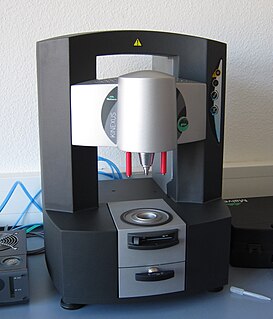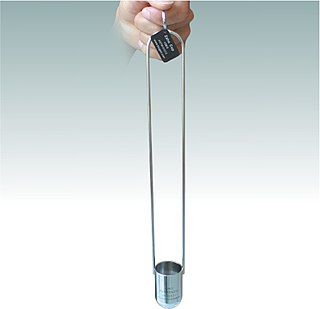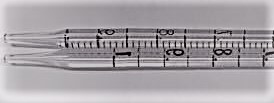A viscometer is an instrument used to measure the viscosity of a fluid. For liquids with viscosities which vary with flow conditions, an instrument called a rheometer is used. Thus, a rheometer can be considered as a special type of viscometer. Viscometers only measure under one flow condition.
Flow measurement is the quantification of bulk fluid movement. Flow can be measured in a variety of ways. The common types of flowmeters with industrial applications are listed below:

A rheometer is a laboratory device used to measure the way in which a liquid, suspension or slurry flows in response to applied forces. It is used for those fluids which cannot be defined by a single value of viscosity and therefore require more parameters to be set and measured than is the case for a viscometer. It measures the rheology of the fluid.
The Atterberg limits are a basic measure of the critical water contents of a fine-grained soil: its shrinkage limit, plastic limit, and liquid limit.

An air flow bench is a device used for testing the internal aerodynamic qualities of an engine component and is related to the more familiar wind tunnel.
Saybolt universal viscosity (SUV), and the related Saybolt FUROL viscosity (SFV), are specific standardised tests producing measures of kinematic viscosity. FUROL is an acronym for fuel and road oil. Saybolt universal viscosity is specified by the ASTM D2161. Both tests are considered obsolete to other measures of kinematic viscosity, but their results are quoted widely in technical literature.

Geotechnical investigations are performed by geotechnical engineers or engineering geologists to obtain information on the physical properties of soil earthworks and foundations for proposed structures and for repair of distress to earthworks and structures caused by subsurface conditions. This type of investigation is called a site investigation. Additionally, geotechnical investigations are also used to measure the thermal resistivity of soils or backfill materials required for underground transmission lines, oil and gas pipelines, radioactive waste disposal, and solar thermal storage facilities. A geotechnical investigation will include surface exploration and subsurface exploration of a site. Sometimes, geophysical methods are used to obtain data about sites. Subsurface exploration usually involves soil sampling and laboratory tests of the soil samples retrieved.

A Zahn cup is a viscosity measurement device widely used in the paint industry. It is commonly a stainless steel cup with a tiny hole drilled in the centre of the bottom of the cup. There is also a long handle attached to the sides. There are five cup specifications, labelled Zahn cup #x, where x is the number from one through five. Large number cup sizes are used when viscosity is high, while low number cup sizes are used when viscosity is low. They are manufactured in accordance to ASTM D 4212, ASTM D1084 and ASTM D816
An Ubbelohde type viscometer or suspended-level viscometer is a measuring instrument which uses a capillary based method of measuring viscosity. It is recommended for higher viscosity cellulosic polymer solutions. The advantage of this instrument is that the values obtained are independent of the total volume. The device was developed by the German chemist Leo Ubbelohde (1877-1964).
The air permeability specific surface of a powder material is a single-parameter measurement of the fineness of the powder. The specific surface is derived from the resistance to flow of air through a porous bed of the powder. The SI units are m2·kg−1 or m2·m−3.

The flow table test or flow test is a method to determine consistency of fresh concrete. Flow table test is also used to identify transportable moisture limit of solid bulk cargoes. It is used primarily for assessing concrete that is too fluid (workable) to be measured using the slump test, because the concrete will not retain its shape when the cone is removed.
Airwatt or air watt is a measurement unit of the effectiveness of vacuum cleaners which refers to airflow and the amount of power (watts) a vacuum cleaner produces and uses. It can also be referred to as a measurement of the energy per unit time of the air flowing through an opening, which is related to the energy that electricity carries through the power cable (wattage).
The concrete slump test measures the consistency of fresh concrete before it sets. It is performed to check the workability of freshly made concrete, and therefore the ease with which concrete flows. It can also be used as an indicator of an improperly mixed batch. The test is popular due to the simplicity of apparatus used and simple procedure. The slump test is used to ensure uniformity for different loads of concrete under field conditions.
Annular velocity is the speed of a fluid's movement in a column called an annulus in wells being drilled with circulating drilling fluid. It is commonly measured in feet per minute (ft/min) or meters per minute (m/min). Annular velocity is often abbreviated as AV, though this is not exclusively so, as AV also refers to apparent viscosity which is calculated from rheometer readings from tests that the mud engineer performs.

The Ford viscosity cup is a simple gravity device that permits the timed flow of a known volume of liquid passing through an orifice located at the bottom. Under ideal conditions, this rate of flow would be proportional to the kinematic viscosity that is dependent upon the specific gravity of the draining liquid. However, the conditions in a simple flow cup are seldom ideal for making true measurements of viscosity. It is important when using a Ford Cup and when retesting liquids that the temperature of the cup and the liquid is maintained, as ambient temperature makes a significant difference to viscosity and thus flow rate.

The viscosity of a fluid is a measure of its resistance to deformation at a given rate. For liquids, it corresponds to the informal concept of "thickness": for example, syrup has a higher viscosity than water.
Spray nozzles are designed to perform under various operating conditions. The following characteristics should be considered when selecting a nozzle:
Flow conditioning ensures that the “real world” environment closely resembles the “laboratory” environment for proper performance of inferential flowmeters like orifice, turbine, coriolis, ultrasonic etc.

A graduated pipette is a pipette with its volume, in increments, marked along the tube. It is used to accurately measure and transfer a volume of liquid from one container to another. It is made from plastic or glass tubes and has a tapered tip. Along the body of the tube are graduation markings indicating volume from the tip to that point. A small pipette allows for more precise measurement of fluids; a larger pipette can be used to measure volumes when the accuracy of the measurement is less critical. Accordingly, pipettes vary in volume, with most measuring between 0 and 25.0 millilitres.
Flow cups are designed to accurately measure the viscosity of paints, inks, varnishes and similar products.









